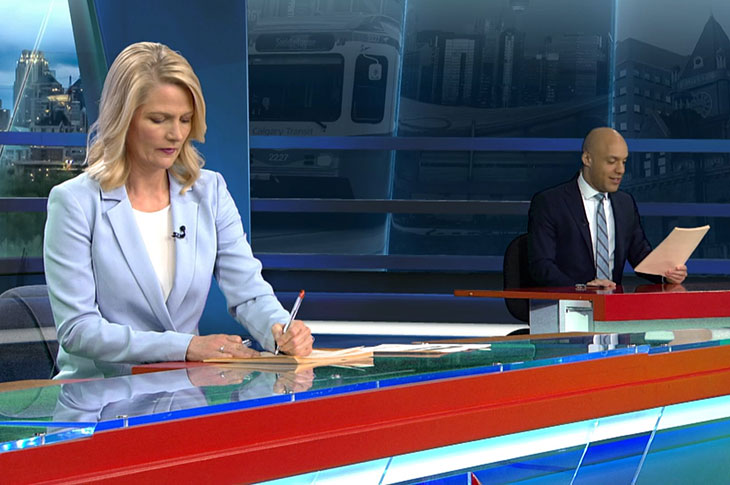Local anchor stays on the air to deliver essential COVID-19 news

It’s the same but it’s different. That’s the way to describe Linda Olsen’s job as a Calgary Global News TV anchor during a world-wide pandemic.
It’s the same as usual because the SAIT grad and honourary degree recipient is still on the air, and remains one of Calgary’s most trusted television journalists. It’s different because of all the changes behind the scenes and on air to meet the new reality created by the COVID-19 virus.
There may be no change to her role as anchor, but Olsen’s job as a newscaster has taken on a new urgency as she reports the impact of the virus on our community. “There’s the added responsibility of making sure that everything is absolutely accurate,” she says. “That's always been our mandate. It’s what we always strive for, but the information around the COVID virus is so critical that you carry that extra weight of telling people what they need to know.
“It’s so important to share this critical information because you need to know what's happening to make wise and safe decisions,” she adds. “Our news has a big impact on people’s lives and their families. We want to be informative and insightful, and we also want to make people smile.”
As for life in the Global newsroom, it’s definitely not business as usual.
For one thing, when Olsen is delivering the evening news, she’s no longer surrounded by her colleagues, her “team,” at the on-air news desk. The weather reporter giving the forecasts is based in his home. All the reporters and their camera people are working remotely. Even Olsen’s co-anchor for the 6 o’clock show, Joel Senick, sits a few metres away.
“Sometimes my instinct is to turn and look toward Joel,” says Olsen “When I did that the other day, somebody texted right away with the message, ’Why did you look the opposite way?’ It actually looked like that on the split-screen. Viewers notice that sort of thing and we have to take it into account.”
As for story assignment meetings, Olsen, the producers and reporters meet by conference call instead of around the usual table. There are very few people working at the TV station and those who are, are working a distance from each other. For example, Olsen is now working in an office way off in the sales department.
Still, Olsen says the decision to work and broadcast from the Global Calgary headquarters is the right decision. “I think the company has done an incredible job of looking out for us and ensuring we feel safe. We have cleaners in every day and we have sanitizing products to clean our workspaces. They've propped open doors so we don't have to touch surfaces. They've made a lot of changes to make us as safe as possible.”
As for all the stories Olsen is delivering to the community about COVID-19, she says they remind her of her time she was reporting on the historic floods that hit Southern Alberta in 2013. “It was then I realized we are an essential service. This isn't just about your local newscast of what's happening down your street. This is what you need to know every day.”
Find out more about SAIT’s everyday heroes — the front-line alumni, instructors, employees and students using their skills to make a difference.

Oki, Âba wathtech, Danit'ada, Tawnshi, Hello.
SAIT is located on the traditional territories of the Niitsitapi (Blackfoot) and the people of Treaty 7 which includes the Siksika, the Piikani, the Kainai, the Tsuut’ina and the Îyârhe Nakoda of Bearspaw, Chiniki and Goodstoney.
We are situated in an area the Blackfoot tribes traditionally called Moh’kinsstis, where the Bow River meets the Elbow River. We now call it the city of Calgary, which is also home to the Métis Nation of Alberta.